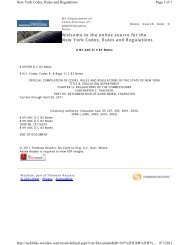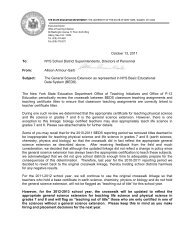ESL Learning Standards - Higher Ed - New York State Education ...
ESL Learning Standards - Higher Ed - New York State Education ...
ESL Learning Standards - Higher Ed - New York State Education ...
You also want an ePaper? Increase the reach of your titles
YUMPU automatically turns print PDFs into web optimized ePapers that Google loves.
Standard 1:<br />
Students will listen, speak, read, and write in English for<br />
information and understanding.<br />
Elementary Grade Sample Classroom Tasks:<br />
English Proficiency Level<br />
Beginning<br />
After a neighborhood walk in which students identify various<br />
jobs and occupations in the community, students work<br />
in pairs to complete a chart for each job observed (e.g., job<br />
title, place of work, description of job duties).<br />
Performance indicators: 2, 7, 10, 13<br />
Intermediate<br />
With a partner, students interview a worker or another<br />
adult about a selected occupation, taking notes on job<br />
details. Students write a brief description of the occupation<br />
and share orally with the class, answering questions from<br />
peers.<br />
Performance indicators: 2, 5, 7, 8, 10, 12, 13, 16<br />
<strong>ESL</strong><br />
1<br />
Elem<br />
Students listen to or read informational text about the environment.<br />
Class uses a graphic organizer provided by the<br />
teacher to organize information in pictures and simple<br />
phrases (e.g., sources of pollution, effects, helpful measures).<br />
Students cut out magazine pictures that illustrate<br />
environmental concepts. Class collaborates on making a<br />
collage, adding a few words or descriptive phrases.<br />
Performance indicators: 1, 4, 6, 7, 16<br />
Students listen to or read two simple illustrated texts about<br />
the life cycle of frogs and salamanders (e.g., Tadpole and<br />
Frog (Stopwatch Series) by Christine Back, and Frogs,<br />
Toads, Lizards and Salamanders by Nancy Winslow<br />
Parker). Using a Venn diagram, class draws and labels pictures<br />
to show differences and similarities between the two<br />
animals.<br />
Performance indicators: 2, 3, 4, 16<br />
Students listen to or read informational text about the environment.<br />
Small groups use graphic organizers created by<br />
class (with teacher’s help) to organize information in phrases<br />
(see Beginning task). Small groups collaborate on making<br />
posters showing different environmental problems and<br />
solutions, including explanatory phrases.<br />
Performance indicators: 1, 4, 6, 7, 13, 16<br />
Students listen to or read two illustrated texts about the life<br />
cycle of frogs and salamanders. Small groups work together<br />
to create Venn diagrams and write phrases showing differences<br />
and similarities. Groups use a variety of sources<br />
(e.g., Zoo Books or Wide World of Animals CD-ROM) to<br />
find additional facts about these animals. Groups collaborate<br />
on creating a question-and-answer book for other<br />
classes.<br />
Performance indicators: 2, 3, 4, 5, 7, 9, 13, 16<br />
42 <strong>Learning</strong> <strong>Standards</strong> for <strong>ESL</strong>
















